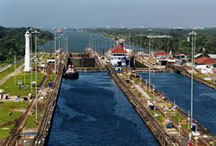 |
 |
|
| eNews • January 2015 | ||
| Promoting a Cost-Effective, Reliable and Competitive Transportation System |
||
 Panama Canal introduces plan for new tolls
Panama Canal introduces plan for new tolls
The Panama Canal Authority announced plans for a new toll structure that is scheduled to go into effect in April 2016, following a public comment period.
Higher tolls are needed for the government to cover the costs of a massive infrastructure expansion project now underway that will enable the passage of much larger ships and increase the waterways capacity. The project has been delayed at least 18 months by bad weather, a bad batch of concrete, contractor liquidity problems and a contract dispute with the international consortium building the third set of locks. The delays have pushed the cost of the project from its original $5.2 billion estimate to more than $7 billion in the eyes of some analysts. The new locks are expected to open to vessel traffic in the first quarter of 2016.
Panama Canal officials face the challenge of figuring out how much toll increases the market will bear given new competition from the Suez Canal and Nicaraguaââ¬â¢s recent decision to begin construction of a new Atlantic-Pacific shortcut that some estimate will cost at least $50 billion. Tolls could also influence the calculation shippers make about whether to reach the U.S. East Coast from Asia using the intermodal land bridge from West Coast ports.
The Panama Canal Authority has spent more than a year briefing each sector of the maritime industry about potential changes to the toll structure. The board of directors approved the proposal on Dec. 24 and the PCA is now inviting public comments, with a public hearing scheduled for Feb. 27. Written comments must be received by 4:15 PM local time on Feb. 9.
ââ¬Å"The proposal, in its current form, safeguards the competitiveness of the waterway, charges a fair price for the value of the route and facilitates the Canalôs goal of providing impeccable service to the global shipping and maritime community,ââ¬Â PCA Administrator Jorge Luis Quijano said in a statement.
The new Panama Canal toll structure varies for each type of vessel and by commodity in the dry bulk class. Container vessels are measured and priced on TEUs, while dry bulk vessels are charged based on deadweight tonnage, and passenger vessels are charged based on available berths. Liquefied natural gas ships will be measured based on cubic meters and tankers will be measured and priced on Panama Canal tons and metric tons.
Container tolls would go up under the new structure, but would allow more flexibility by assigning a portion of the fee to the actual container volume carried on board, rather than just on vessel capacity, according to the PCA.
Containerships would pay less per TEU for larger ships as part of the PCAââ¬â¢s effort to encourage the use of larger vessels.
The PCA also said it will institute for the first time a customer loyalty program for container ships. Frequent container customers will receive premium prices once a certain TEU volume threshold is reached.
The new toll structure will apply to the existing Canal as well as the new traffic lane, the PCA said.
The last tolls modification was put into effect in 2012-2013 for dry bulk vessels, tankers, chemical carriers, gas carriers, vehicle carriers, general cargo and other vessel types segments. Container, reefer and passenger tolls have remained unchanged since 2011.
The proposed tolls include significant reductions in the capacity-based charge, and price differentiation based on vessel size ranges. The PCA said the new framework allows it to share with customers the risks associated with fluctuating economic conditions and lower-utilization return voyages.
LNG carriers, which currently cannot transit the Canal because of their width, will receive an incentive for roundtrip voyages in the form of reduced ballast fees if the empty transit is made within 60 days after the laden transit.
Dry bulk tolls will differ based on whether the vessel is carrying grain, coal, iron ore or other bulk cargo. The PCA said the rates have been designed to encourage the deployment of larger vessels through the waterway. Dry bulk vessels transiting the Panamax locks will be charged a capacity price based on the vesselââ¬â¢s deadweight tonnage. Dry bulkers transiting the new locks will use a capacity price based on the vesselââ¬â¢s deadweight tonnage and a cargo charge based on the amount of cargo on-board the vessel in metric tons.
Tankers transiting the Panamax locks will be charged a fixed price based on the Panama Canal Universal Measurement System (PC/UMS) tonnage. Tankers transiting the new locks will be applied a capacity price based on PC/UMS tonnage and a cargo carried pricing scheme based on metric tons. Reduced ballast rates will be provided in the tanker segment to attract vessels on their return voyage.
PC/UMS tolls will continue to apply for general cargo and reefer ships regardless of the toll system used.
Last week, a dispute adjudication board ruled in favor of the GUPC consortium in its dispute and ordered the Canal Authority to pay the group $234 million.
SOURCE: AMERICAN SHIPPER
Soy Transportation Coalition |
|
